Hydrological Cycle Performance at a Permeable Pavement Site and a Raingarden Site in a Subtropical Region
Abstract
:1. Introduction
2. Materials and Methods
2.1. Flowchart of This Study
2.2. Two Field Cases
2.3. Modeling Tool
3. Results and Discussion
3.1. Observed Performance of Permeable Pavement
3.2. Observed Performance of the Raingarden
3.3. Model Calibration and Verification
3.4. Annual Hydrological Cycles at the Permeable Pavement and Raingarden Sites in the Verified Model Simulations
4. Conclusions
Author Contributions
Funding
Institutional Review Board Statement
Informed Consent Statement
Data Availability Statement
Conflicts of Interest
References
- Bae, C.; Lee, D.K. Effects of low-impact development practices for flood events at the catchment scale in a highly developed urban area. Int. J. Disaster Risk Reduct. 2020, 44, 101412. [Google Scholar] [CrossRef]
- de Macedo, M.B.; Gomes Júnior, M.N.; de Oliveira, T.R.P.; Giacomoni, M.H.; Imani, M.; Zhang, K.; do Lago, C.A.F.; Mendiondo, E.M. Low Impact Development practices in the context of United Nations Sustainable Development Goals: A new concept, lessons learned and challenges, Critical Reviews in Environmental Science and Technology. Crit. Rev. Environ. Sci. Technol. 2020, 52, 2538–2581. [Google Scholar] [CrossRef]
- US Environmental Protection Agency. Low Impact Development (LID). A Literature Review; EPA Office of Water: Washington, DC, USA, 2000.
- Fletcher, T.D.; Shuster, W.; Hunt, W.F.; Ashley, R.; Butler, D.; Arthur, S.; Trowsdale, S.; Barraud, S.; Semadeni-Davies, A.; Bertrand-Krajewski, J.L.; et al. SUDS, LID, BMPs, WSUD and more—The evolution and application of terminology surrounding urban drainage. Urban Water J. 2015, 12, 525–542. [Google Scholar] [CrossRef]
- Wong, T.H.F.; Allen, R.; Brown, R.R.; Deletic, A.; Fletcher, T.D.; Gangadharan, L.; Gernjak, W.; Jakob, C.; O’Loan, T.; Reeder, M.; et al. Stormwater Management in a Water Sensitive City: Blueprint 2012; The Centre for Water Sensitive Cities: Melbourne, Australia, 2012. [Google Scholar]
- Kato, H. The Trend in Measures Against Urban Inundation in Japan. J. Disaster Res. 2020, 16, 415–420. [Google Scholar] [CrossRef]
- Nguyen, T.T.; Ngo, H.H.; Guo, W.S.; Wang, X.C.C.; Ren, N.Q.; Li, G.B.; Ding, J.; Liang, H. Implementation of a specific urban water management—Sponge City. Sci. Total Environ. 2019, 652, 147–162. [Google Scholar] [CrossRef]
- Tirpak, R.A.; Winston, R.J.; Feliciano, M.; Dorsey, J.D.; Epps, T.H. Impacts of permeable interlocking concrete pavement on the runoff hydrograph: Volume reduction, peak flow mitigation, and extension of lag times. Hydrol. Process. 2021, 35, 14167. [Google Scholar] [CrossRef]
- Alyaseri, I.; Zhou, J. Stormwater Volume Reduction in Combined Sewer Using Permeable Pavement: City of St. Louis. Int. J. Environ. Eng. 2016, 142, 04016002. [Google Scholar] [CrossRef]
- Liu, Y.; Li, T.; Yu, L. Urban heat island mitigation and hydrology performance of innovative permeable pavement: A pilot-scale study. J. Clean. Prod. 2022, 244, 118938. [Google Scholar] [CrossRef]
- Shafique, M.; Kim, R.; Kyung-Ho, K. Rainfall Runoff Mitigation by Retrofitted Permeable Pavement in an Urban Area. Sustainability 2019, 10, 1231. [Google Scholar] [CrossRef] [Green Version]
- Cheng, Y.Y.; Lo, S.L.; Ho, C.C.; Lin, J.Y.; Yu, S.L. Field Testing of Porous Pavement Performance on Runoff and Temperature Control in Taipei City. Water 2019, 11, 2635. [Google Scholar] [CrossRef] [Green Version]
- Asleson, B.C.; Nestingen, R.S.; Gulliver, J.S.; Hozalski, R.M.; Nieber, J.L. Performance Assessment of Rain Gardens. J. Am. Water Resour. Assoc. 2009, 45, 1019–1031. [Google Scholar] [CrossRef]
- Sharma, R.; Malaviya, P. Management of stormwater pollution using green infrastructure: The role of rain gardens. Wiley Interdiscip. Rev. Water 2021, 8, e1507. [Google Scholar] [CrossRef]
- Jennings, A.A.; Berger, M.A.; Hale, J.D. Hydraulic and Hydrologic Performance of Residential Rain Gardens. J. Environ. Eng. 2015, 141, 04015033. [Google Scholar] [CrossRef]
- Bethke, G.M.; William, R.; Stillwell, A.S. Rain Garden Performance as a Function of Native Soil Parameters. J. Sustain. Water Built Environ. 2022, 8, 04021021. [Google Scholar] [CrossRef]
- Amur, A.; Wadzuk, B.; Traver, R. Analyzing the Performance of a Rain Garden over 15 Years: How Predictable Is the Rain Garden’s Response? In Proceedings of the International Low Impact Development Conference 2020, Bethesda, MD, USA, 20–24 July 2020. [Google Scholar]
- Nichols, W.; Welker, A.; Traber, R.; Tu, M.C. Modeling Seasonal Performance of Operational Urban Rain Garden Using HYDRUS-1D. J. Sustain. Water Built Environ. 2021, 7, 04021005. [Google Scholar] [CrossRef]
- Lee, J.M.; Hyun, K.H.; Choi, J.S. Analysis of the impact of low impact development on runoff from a new district in Korea. Water Sci. Technol. 2013, 68, 1315–1321. [Google Scholar] [CrossRef]
- Luan, Q.; Fu, X.; Song, C.; Wang, H.; Liu, J.; Wang, Y. Runoff effect evaluation of LID through SWMM in typical mountainous, low-lying urban areas: A case study in China. Water 2017, 9, 439. [Google Scholar] [CrossRef] [Green Version]
- Li, Q.; Wang, F.; Yu, Y.; Huang, Z.; Li, M.; Guan, Y. Comprehensive performance evaluation of LID practices for the sponge city construction: A case study in Guangxi, China. J. Environ. Manag. 2019, 231, 10–20. [Google Scholar] [CrossRef]
- Zhu, H.; Yu, M.; Zhu, J.; Cao, R. Simulation study on effect of permeable pavement on reducing flood risk of urban runoff. Int. J. Transp. Eng. 2019, 8, 373–382. [Google Scholar] [CrossRef]
- Goncalves, M.L.; Zischg, J.; Rau, S.; Sitzmann, M.; Rauch, W.; Kleidorfer, M. Modeling the effects of introducing low impact development in a tropical city: A case study from Joinville. Sustainability 2018, 10, 728. [Google Scholar] [CrossRef] [Green Version]
- Turco, M.; Brunetti, G.; Carbone, M.; Piro, P. Modelling the hydraulic behaviour of permeable pavements through a reservoir element model. Hydrol. Water Resour. 2018, 18, 507–514. [Google Scholar]
- Carbone, M.; Turco, M.; Nigro, G.; Piro, P. Modeling of hydraulic behaviour of green roof in catchment scale. In Proceedings of the 14th International Multidisciplinary Scientific GeoConference SGEM 2014, Albena, Bulgariab, 17–26 June 2014; pp. 471–478. [Google Scholar]
- Baek, S.S.; Ligaray, M.; Pyo, J.; Park, J.P.; Kang, J.H.; Pachepsky, Y.; Chun, J.A.; Cho, K.H. A novel water quality module of the SWMM model for assessing low impact development (LID) in urban watersheds. J. Hydrol. 2020, 586, 1124886. [Google Scholar] [CrossRef]
- Lin, J.Y.; Yuan, T.C.; Chen, C.F. Water Retention Performance at Low-Impact Development (LID) Field Sites in Taipei, Taiwan. Sustainability 2021, 13, 759. [Google Scholar] [CrossRef]
- Rossman, L.A. Storm Water Management Model User’s Manual Version 5.1; U.S. Environmental Protection Agency: Cincinnati, OH, USA, 2015.
- Moriasi, D.N.; Arnold, J.G.; Van Liew, M.W.; Bingner, R.L.; Harmel, R.D.; Veith, T.L. Model evaluation guidelines for systematic quantification of accuracy in watershed simulations. Trans. ASABE 2007, 50, 885–900. [Google Scholar] [CrossRef]
- Cui, X.; Zhang, J.; Huang, D.; Tang, W.; Wang, L.; Hou, F. Experimental simulation of rapid clogging process of pervious concrete pavement caused by storm water runoff. Int. J. Pavement Eng. 2019, 20, 24–32. [Google Scholar] [CrossRef]
- Ma, Y.; Chen, X.; Geng, Y.; Zhang, X. Effect of clogging on the permeability of porous asphalt pavement. Adv. Mater. Sci. Eng. 2020, 2020, 4851291. [Google Scholar] [CrossRef] [Green Version]
- Razzaghmanesh, M.; Beecham, S. A Review of Permeable Pavement Clogging Investigations and Recommended Maintenance Regimes. Water 2018, 10, 337. [Google Scholar] [CrossRef] [Green Version]
- Pezzaniti, D.; Beecham, S.; Kandasamy, J. Influence of clogging on the effective life of permeable pavements. In Proceedings of the Institution of Civil Engineers-Water Management; Thomas Telford Ltd.: London, UK, 2009; Volume 162, pp. 211–220. [Google Scholar]
- Kia, A.; Wong, H.S.; Cheeseman, C.R. Clogging in permeable concrete: A review. J. Environ. Manag. 2017, 193, 221–233. [Google Scholar] [CrossRef]


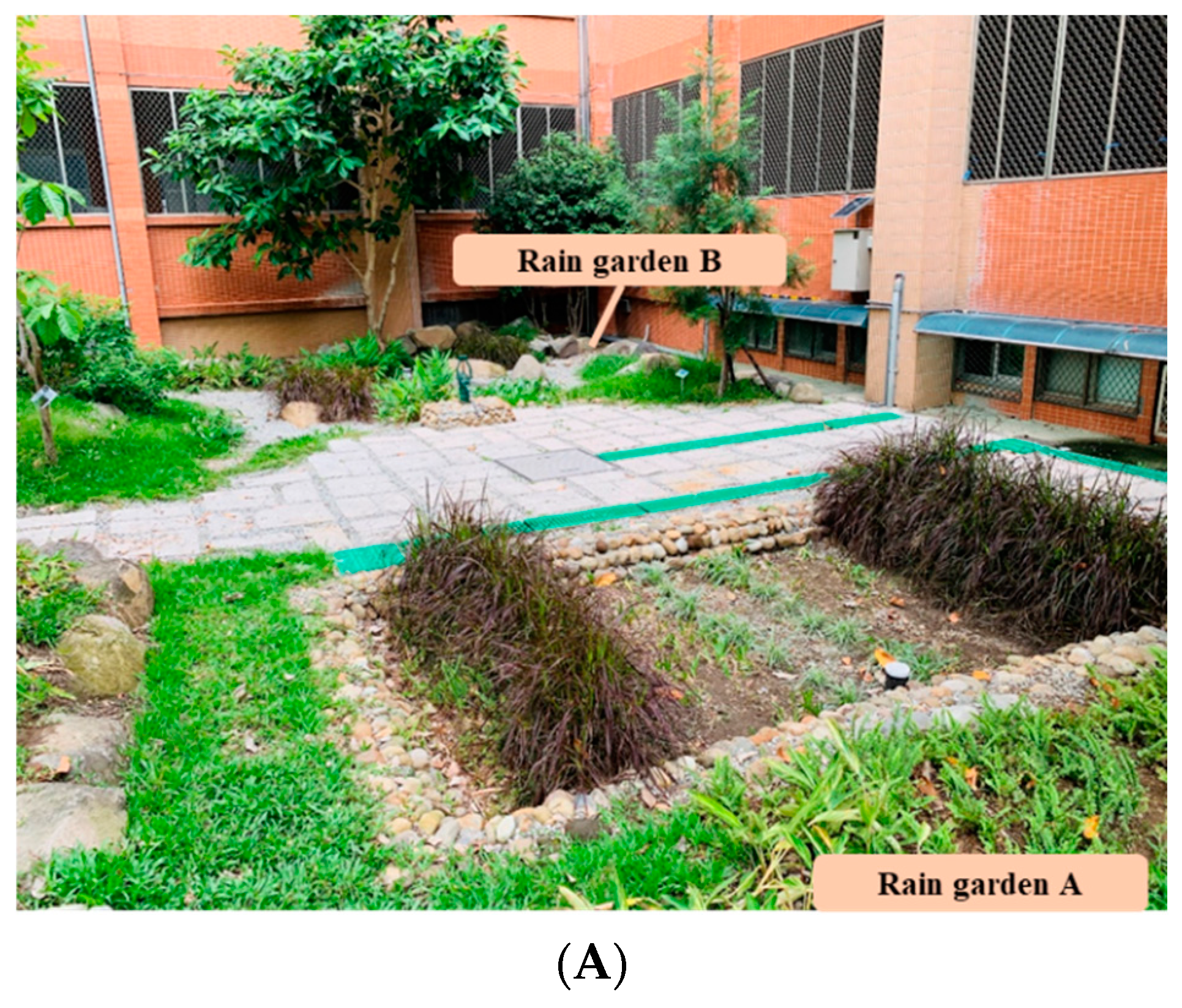
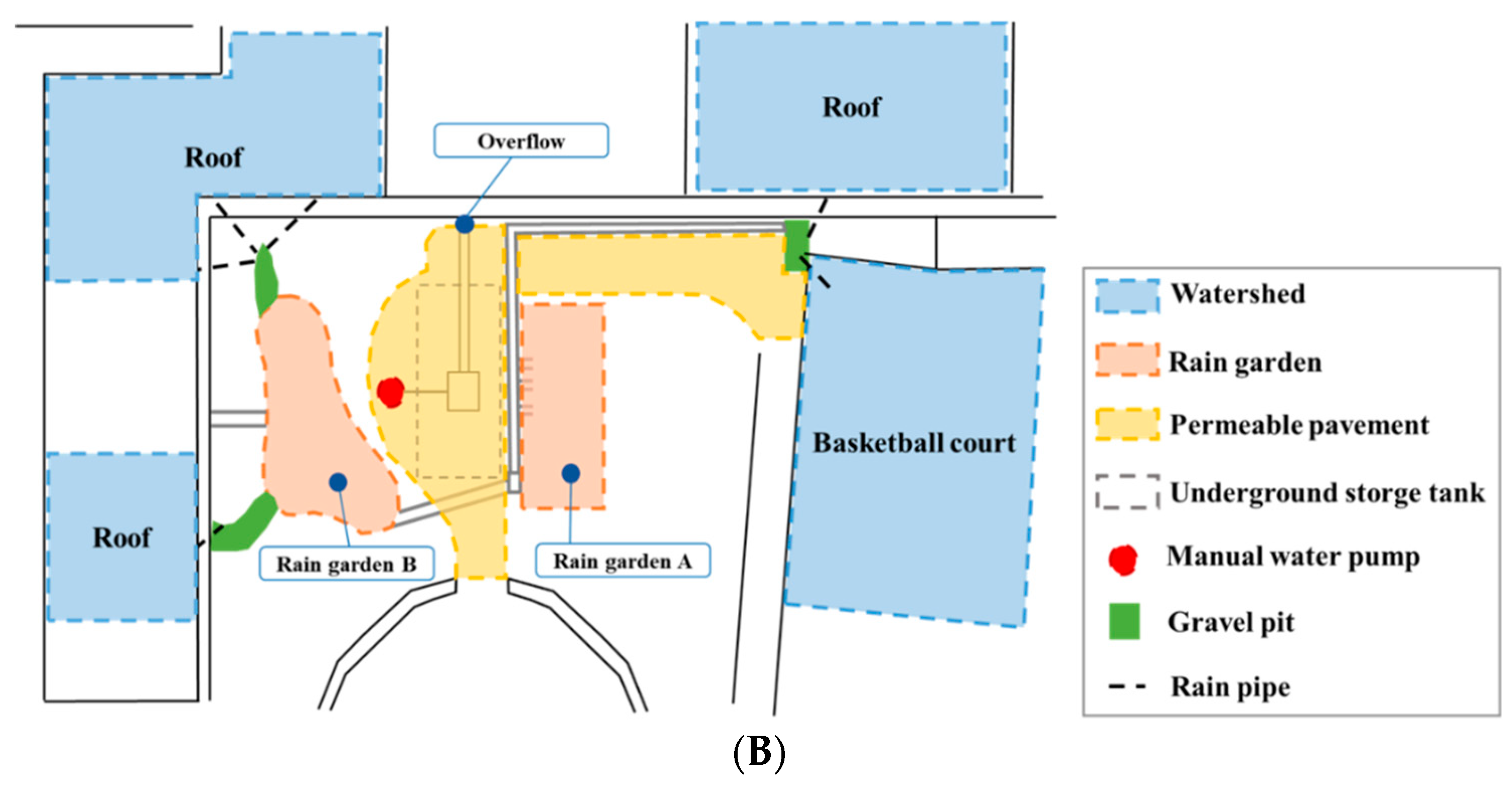
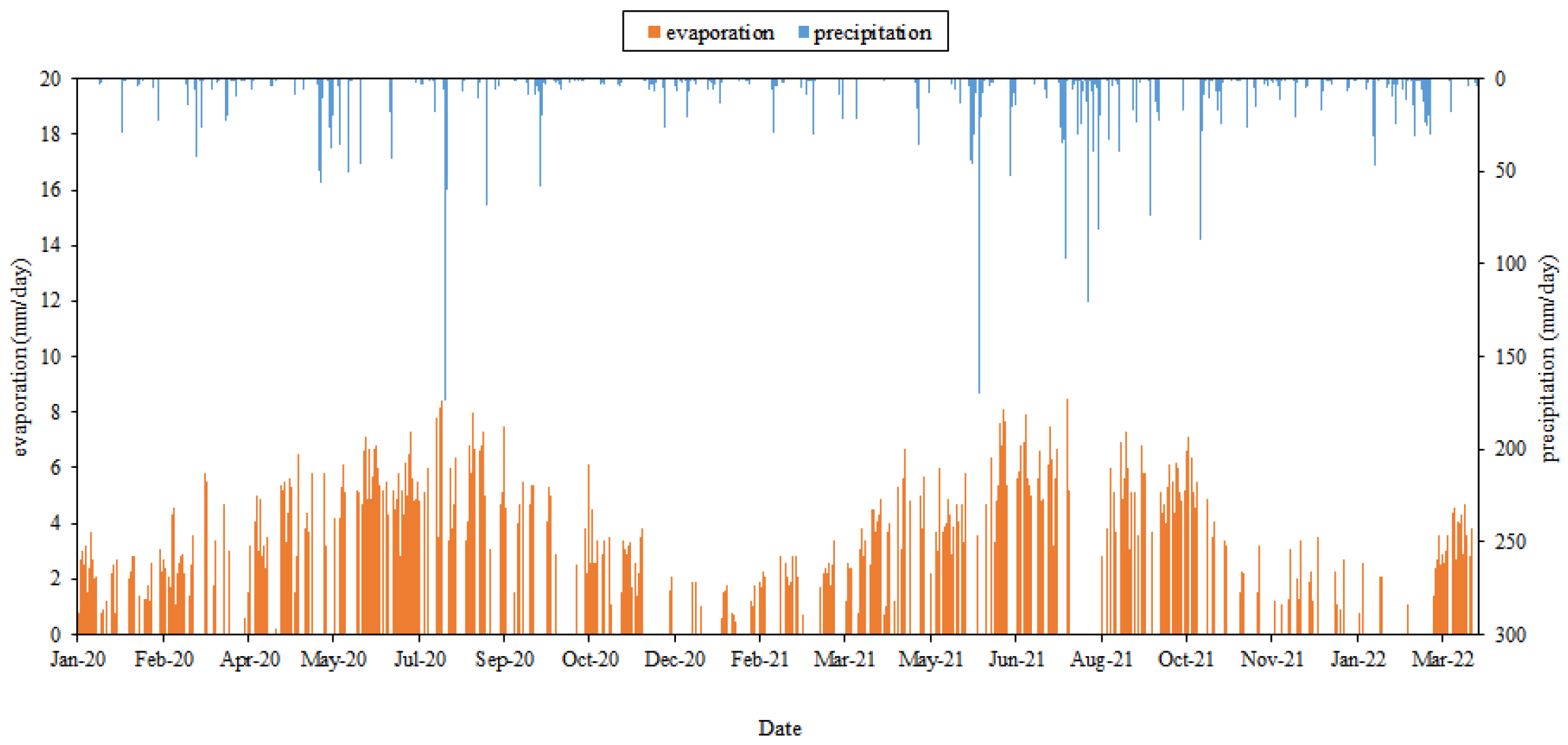
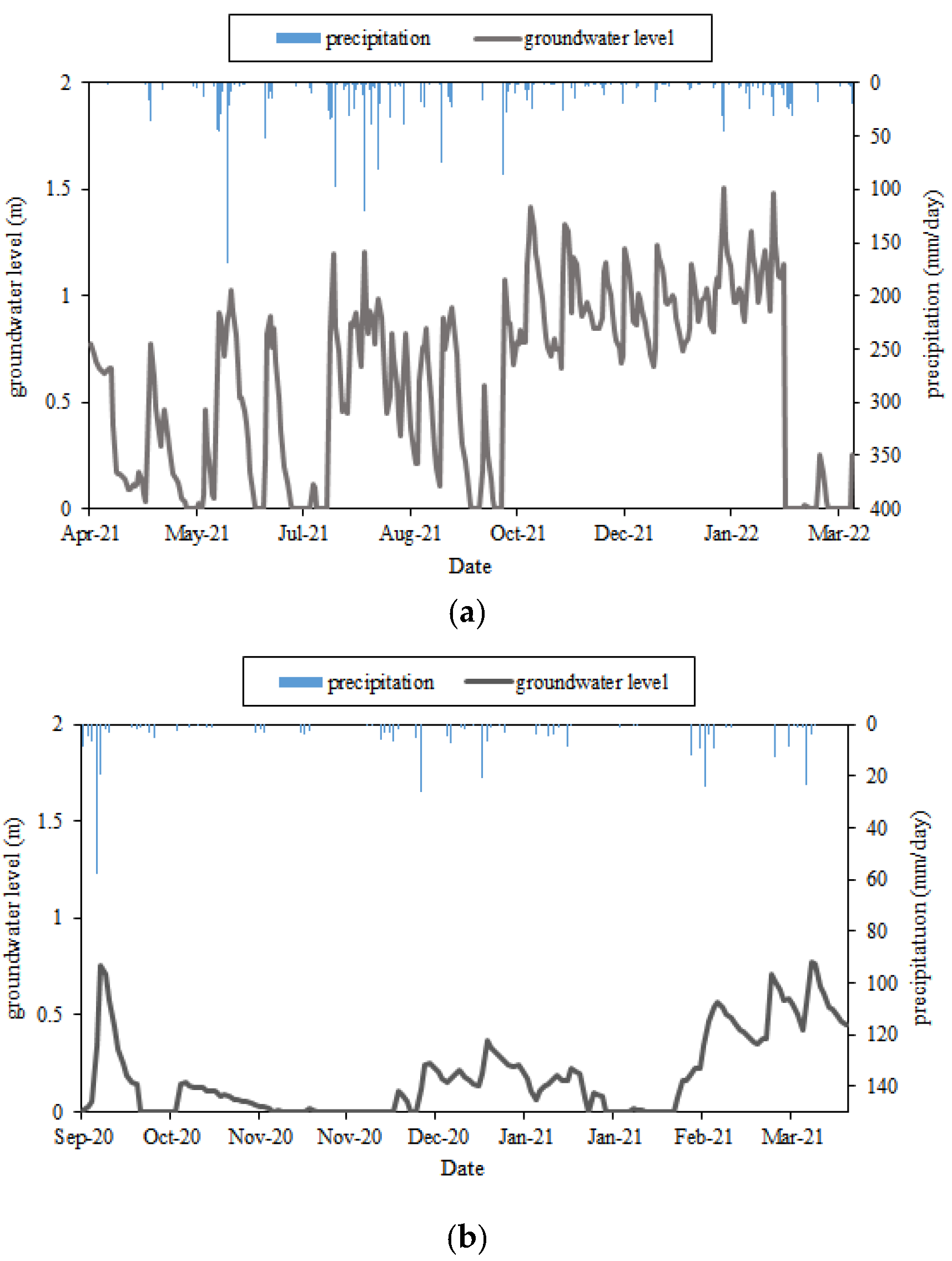
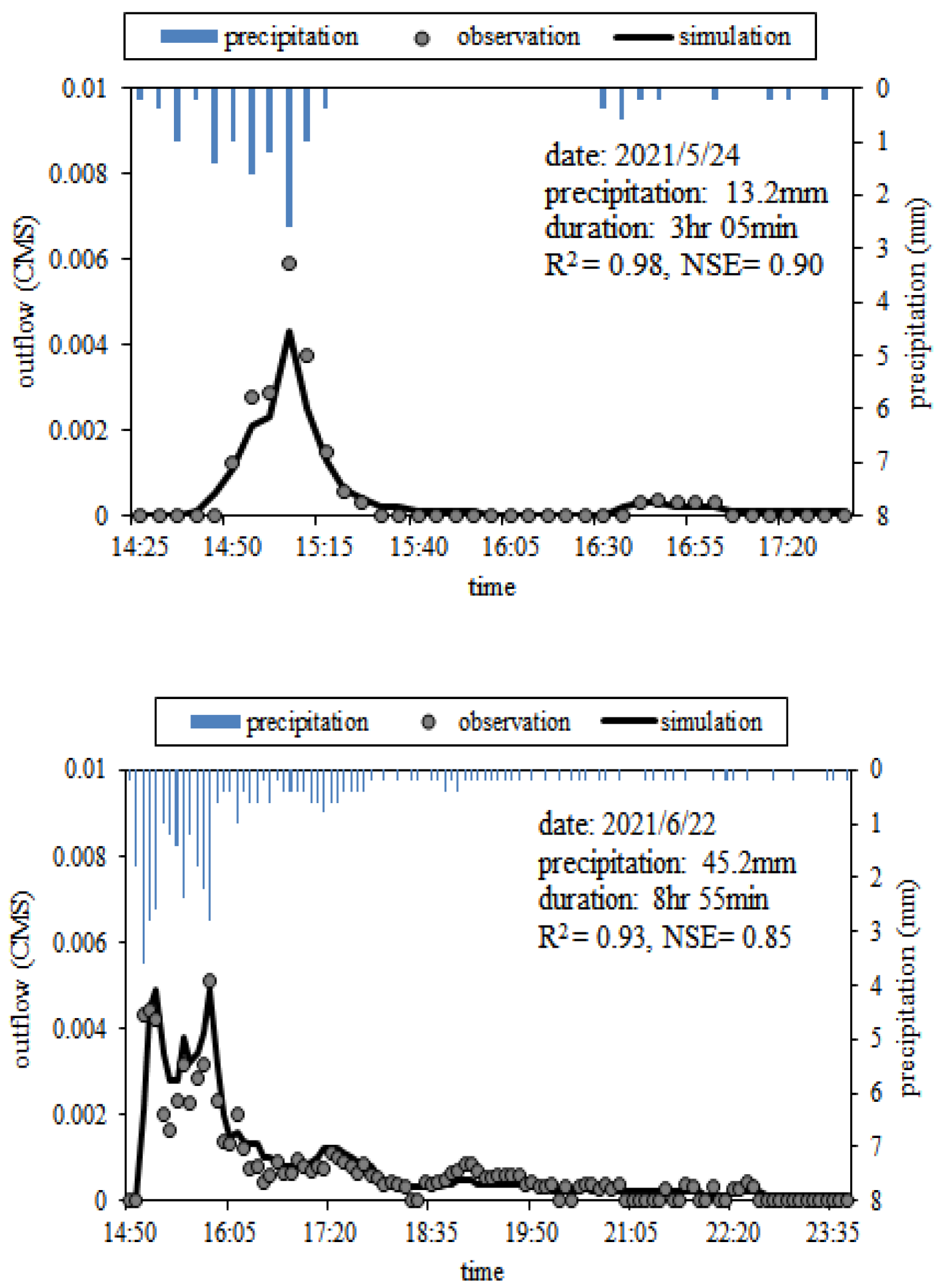

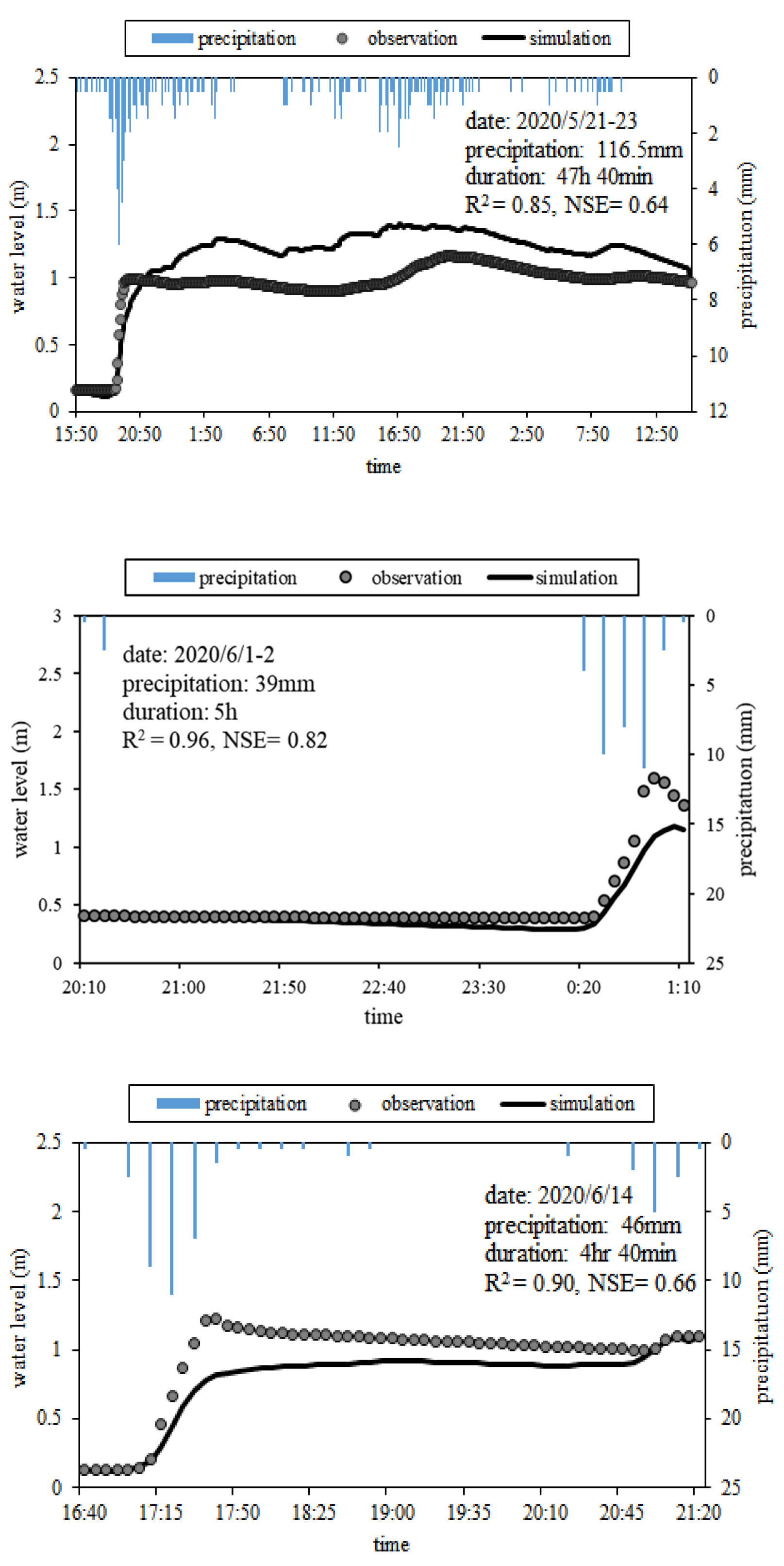



| Date (yy/mm/dd) | Rainfall (mm) | Rainfall (m3) | Outflow (m3) | Reduction Rate (%) |
|---|---|---|---|---|
| 2021/3/24 | 22.0 | 13.5 | 10.5 | 22.8 |
| 2021/4/28–29 | 51.4 | 31.6 | 26 | 17.7 |
| 2021/5/5 | 7.4 | 4.6 | 3.2 | 30.8 |
| 2021/5/24 | 13.2 | 8.1 | 6.8 | 16.5 |
| 2021/05/30–31 | 43.8 | 27.0 | 24.0 | 11.0 |
| 2021/5/31 | 46.2 | 28.4 | 25.7 | 9.7 |
| 2021/6/1 | 30 | 18.5 | 16.4 | 11.0 |
| 2021/6/4–6 | 181 | 111.4 | 105.9 | 5.0 |
| 2021/6/22 | 45.2 | 27.8 | 23.4 | 15.8 |
| 2021/6/23–24 | 22.2 | 13.7 | 11.2 | 17.7 |
| 2021/6/25 | 13.8 | 8.5 | 6.8 | 20.2 |
| 2021/7/21–24 | 189.6 | 116.7 | 100.0 | 14.3 |
| 2021/7/31 | 30.6 | 18.8 | 15.8 | 16.0 |
| 2021/8/2 | 24.4 | 15.0 | 12.8 | 14.8 |
| 2021/8/6–7 | 133.4 | 82.1 | 70.8 | 13.8 |
| 2021/8/10 | 39.8 | 24.5 | 21.9 | 10.4 |
| 2021/8/13 | 81.6 | 50.2 | 47.6 | 5.2 |
| 2021/8/14 | 19.6 | 12.1 | 10.4 | 13.9 |
| 2021/8/19 | 33.2 | 20.4 | 18.3 | 10.6 |
| 2021/8/25 | 39.8 | 24.5 | 21.7 | 11.4 |
| 2021/9/2 | 17.4 | 10.7 | 9.1 | 15.3 |
| 2021/9/4 | 23.4 | 14.4 | 12.3 | 14.7 |
| 2021/9/11–12 | 74.8 | 46.0 | 41.0 | 10.9 |
| 2021/9/16 | 14 | 8.6 | 7.6 | 11.5 |
| 2021/9/17 | 22.6 | 13.9 | 12.5 | 10.4 |
| 2021/10/1 | 17 | 10.5 | 9.3 | 10.9 |
| 2021/10/11–13 | 115.4 | 71.0 | 61.8 | 12.9 |
| 2021/10/21–22 | 21.6 | 13.3 | 10.0 | 24.8 |
| 2021/10/23–25 | 33 | 20.3 | 15.5 | 23.7 |
| 2021/11/8 | 24.8 | 15.3 | 13.4 | 12.1 |
| 2021/11/12–13 | 19.4 | 11.9 | 10.0 | 16.2 |
| 2021/11/25–27 | 15.8 | 9.7 | 7.8 | 20.2 |
| 2021/12/6–7 | 22.6 | 13.9 | 11.0 | 21.0 |
| 2021/12/21–22 | 24.6 | 15.1 | 12.7 | 16.4 |
| 2022/1/21–22 | 30.8 | 19.0 | 16.2 | 14.4 |
| 2022/1/22 | 46.6 | 28.7 | 25.0 | 12.9 |
| 2022/2/3 | 27.2 | 16.7 | 13.7 | 18.0 |
| 2022/2/13–14 | 45.4 | 27.9 | 24.5 | 12.3 |
| 2022/2/19–23 | 117.8 | 72.5 | 66.9 | 7.8 |
| 2022/3/6–7 | 18.4 | 11.3 | 9.7 | 14.1 |
| 2022/3/22–23 | 20.4 | 12.6 | 11.0 | 12.5 |
| Average | 44.4 | 27.3 | 24.4 | 14.7 |
| Date (yy/mm/dd) | Rainfall (mm) | Rainfall (m3) | Outflow (m3) | Reduction Rate (%) |
|---|---|---|---|---|
| 2020/1/26–27 | 31.0 | 11.2 | 0.0 | 100.0 |
| 2020/2/16 | 16.5 | 5.9 | 0.0 | 100.0 |
| 2020/3/4 | 18.0 | 6.5 | 0.0 | 100.0 |
| 2020/3/9–10 | 48.5 | 17.5 | 0.0 | 100.0 |
| 2020/3/13 | 19.0 | 6.8 | 0.0 | 100.0 |
| 2020/3/27 | 22.5 | 8.1 | 0.0 | 100.0 |
| 2020/3/28 | 20.0 | 7.2 | 0.0 | 100.0 |
| 2020/5/21–23 | 116.5 | 41.9 | 0.2 | 99.6 |
| 2020/5/27–28 | 64.5 | 23.2 | 0.0 | 100.0 |
| 2020/6/1–2 | 39.0 | 14.0 | 2.4 | 82.6 |
| 2020/6/7 | 51.0 | 18.4 | 0.0 | 100.0 |
| 2020/6/14 | 46.0 | 16.6 | 0.9 | 94.5 |
| 2020/7/1 | 18.5 | 6.7 | 0.0 | 100.0 |
| 2020/7/2 | 43.0 | 15.5 | 0.0 | 100.0 |
| 2020/7/28 | 18.0 | 6.5 | 0.0 | 100.0 |
| 2020/8/3 | 179.5 | 64.6 | 5.1 | 92.2 |
| 2020/8/4 | 60.0 | 21.6 | 1.5 | 93.1 |
| 2020/8/22–23 | 13.5 | 4.9 | 0.0 | 100.0 |
| 2020/8/27 | 68.5 | 24.7 | 0.0 | 100.0 |
| 2020/9/24–25 | 13.5 | 4.9 | 0.0 | 100.0 |
| 2020/9/26–27 | 58.5 | 21.1 | 0.0 | 100.0 |
| 2020/9/28 | 19.5 | 7.0 | 0.0 | 100.0 |
| 2020/12/8–9 | 30.5 | 11.0 | 0.0 | 100.0 |
| 2020/12/23 | 20.5 | 7.4 | 0.0 | 100.0 |
| Average | 43.2 | 15.6 | 0.4 | 98.4 |
| Parameters | Permeable Pavement Site | Raingarden Site | Unit | Data Sources |
|---|---|---|---|---|
| Layer | Surface | |||
| Berm height | 0 | 550 | mm | actual value |
| Surface roughness | 0.011 | 0.24 | - | calibrated value |
| Surface slope | 0.92 | 1 | % | actual value |
| Layer | Pavement | |||
| Thickness | 240 | X * | mm | actual value |
| Void ratio | 0.17 | X | - | actual value |
| Impervious surface fraction | 0.01 | X | - | actual value |
| Permeability | 10.9 | X | mm/h | calibrated value |
| Layer | Soil | |||
| Thickness | 40 | 300 | mm | actual value |
| Porosity | 0.4 | 0.3 | volume fraction | actual value |
| Conductivity | 0.5 | 0.4 | mm/h | calibrated value |
| Suction head | 3.5 | 3.5 | mm | calibrated value |
| Layer | Storage | |||
| Thickness | X | 250 | mm | actual value |
| Void ratio | X | 0.3 | - | actual value |
| Seepage rate | X | 0.5 | mm/h | calibrated value |
| Field Sites | Year | Rainfall (mm) | Evaporation (mm) | Outflow (mm) | Infiltration (mm) |
|---|---|---|---|---|---|
| Permeable pavement site | 2021 | 2095.2 | 662.06 | 948.49 | 484.48 |
| Raingarden site | 2020 | 1308.5 | 59.72 | 53.05 | 1195.73 (infiltration and storage) |
Publisher’s Note: MDPI stays neutral with regard to jurisdictional claims in published maps and institutional affiliations. |
© 2022 by the authors. Licensee MDPI, Basel, Switzerland. This article is an open access article distributed under the terms and conditions of the Creative Commons Attribution (CC BY) license (https://creativecommons.org/licenses/by/4.0/).
Share and Cite
Chen, C.-F.; Lin, J.-W.; Lin, J.-Y. Hydrological Cycle Performance at a Permeable Pavement Site and a Raingarden Site in a Subtropical Region. Land 2022, 11, 951. https://doi.org/10.3390/land11060951
Chen C-F, Lin J-W, Lin J-Y. Hydrological Cycle Performance at a Permeable Pavement Site and a Raingarden Site in a Subtropical Region. Land. 2022; 11(6):951. https://doi.org/10.3390/land11060951
Chicago/Turabian StyleChen, Chi-Feng, Jhe-Wei Lin, and Jen-Yang Lin. 2022. "Hydrological Cycle Performance at a Permeable Pavement Site and a Raingarden Site in a Subtropical Region" Land 11, no. 6: 951. https://doi.org/10.3390/land11060951
APA StyleChen, C.-F., Lin, J.-W., & Lin, J.-Y. (2022). Hydrological Cycle Performance at a Permeable Pavement Site and a Raingarden Site in a Subtropical Region. Land, 11(6), 951. https://doi.org/10.3390/land11060951








